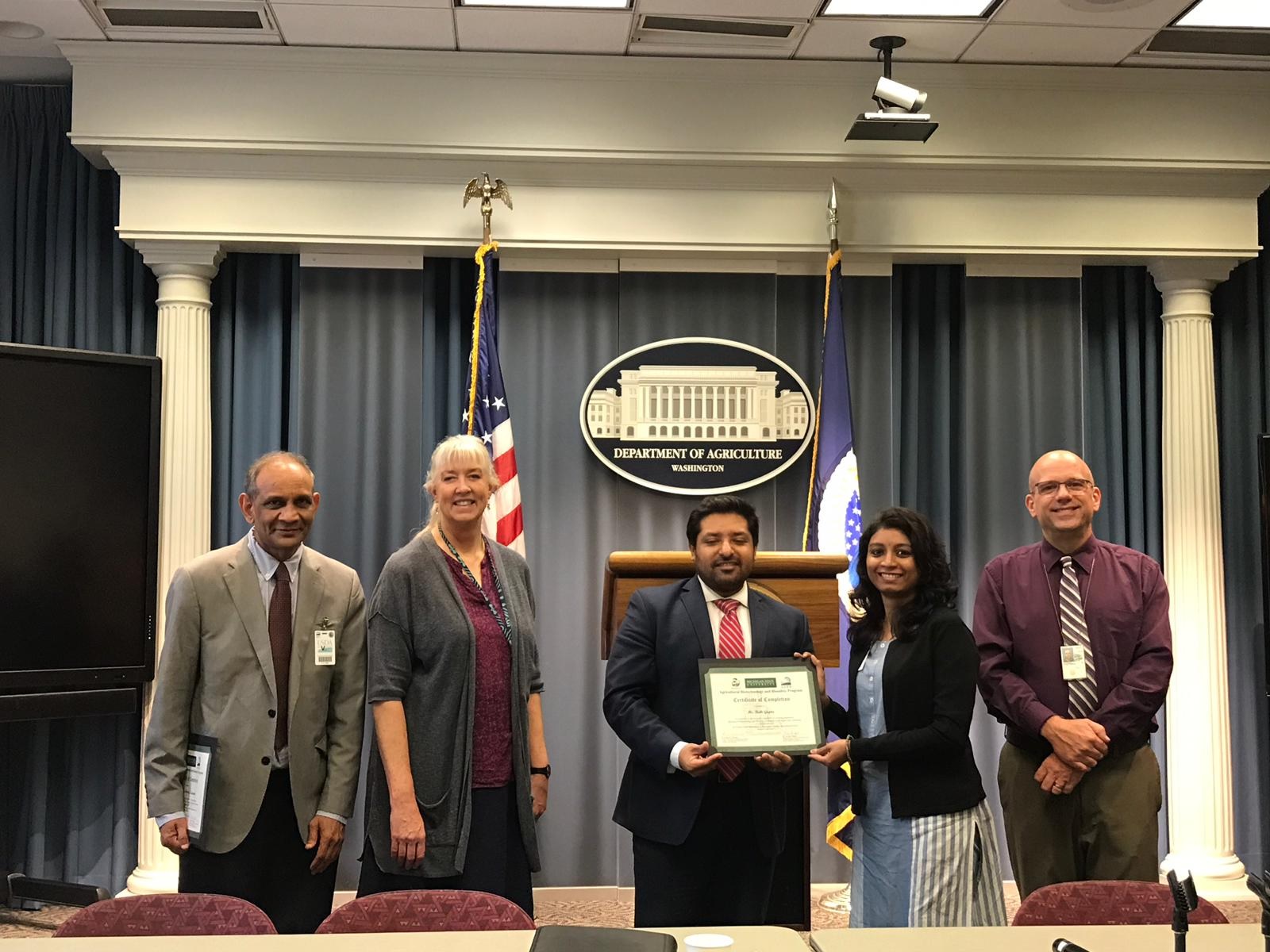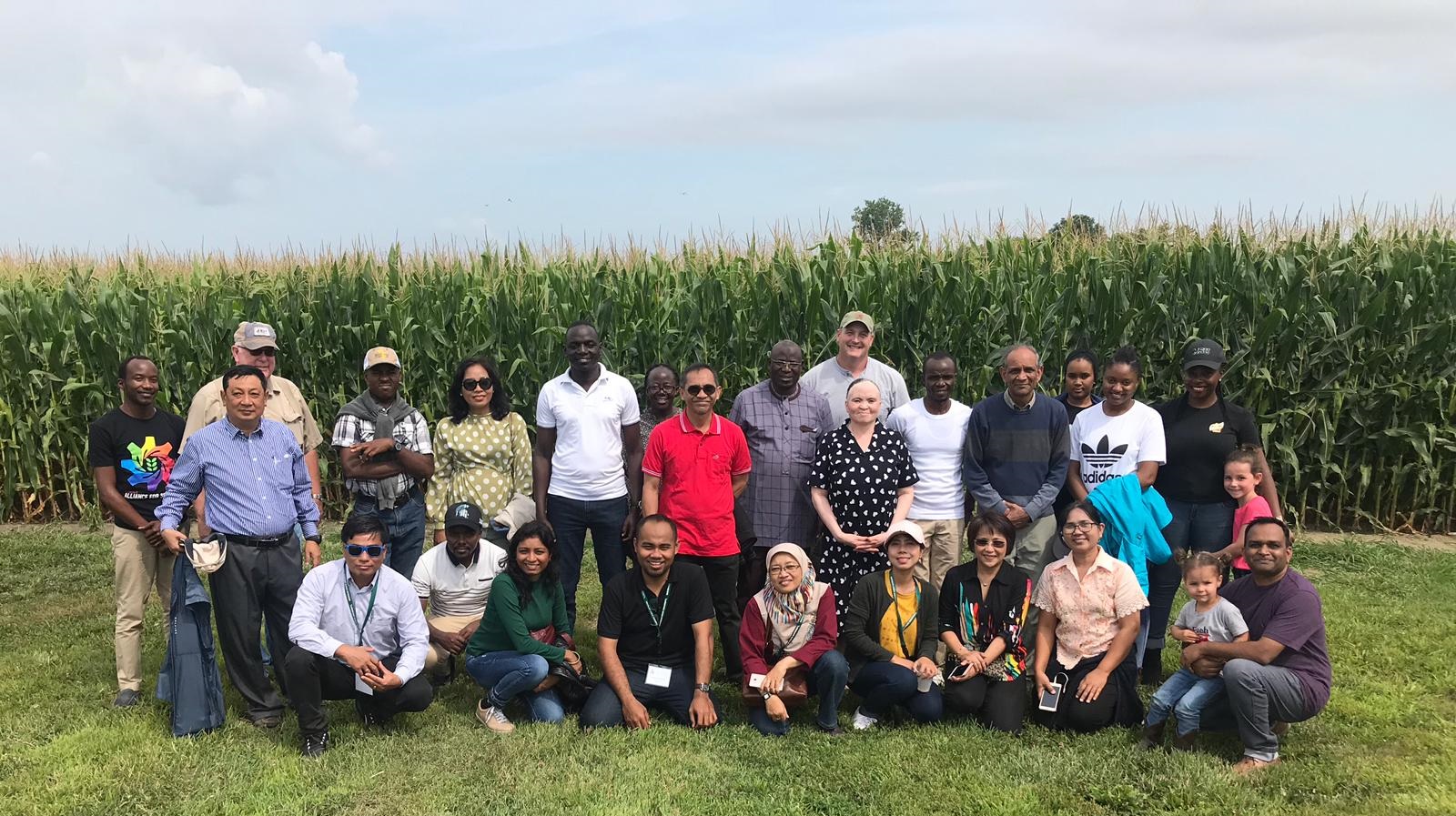B.K. Sarmah and Rubi Gupta
DBT-NECAB
Assam Agricultural University
Jorhat- 13
bidyutsarmah@aau.ac.in
Biosafety can be described as the efforts taken up in order to reduce or eliminate the potential risks resulting from biotechnology and its products (Zaid, 2001). Genetically Modified (GM) food crops (legally called as Genetically Engineered crops or Biotech crops) were introduced commercially in 1994. The DNA of Genetically Engineered crop is modified using Recombinant DNA Technology. In most cases, the aim of genetic modification is to introduce new traits into the plant which naturally does not occur in the species. These varieties are superior to their natural counterparts. In contrast, the conventionally-bred varieties developed through artificial selection, random mutagenesis, or due to intra- or inter-specific (rarely inter-generic) hybridization result in transfer of a number of uncharacterized genes from the same or a related species. Therefore, the major difference between GM crops and conventionally bred varieties is the technology for gene transfer, and the nature of genes transferred (Ronald, 2011). Moreover, the genetic modification is more precise and targeted without any linkage drag than the conventionally bred varieties. The chances of unintended changes in conventional varieties are higher than the GM crops (Coll et al., 2009). As such, a comprehensive scientific knowledge is required to question on the biosafety of GM crops and this requires great skill and understanding to represent the information on GMOs in a credible way for creating an unbiased view on them.
Currently, Genetically Engineered, also called transgenic plants are cultivated in more than 191.7 million hectares in the world in 27 countries while in 1996, only 1.7 million hectares of land were under transgenic crops (ISAAA, 2018). In India, genetically engineered cotton (popularly known as Bt cotton) for insect resistance is the only GM crop released for commercial cultivation, and now India has become the second largest producer of cotton and a leading exporter in the world (Choudhary and Gaur, 2010; ISAA, 2018).
The world population is rising and will reach about 9.5 billion by the year 2050, as per current statistics (Bakshi et al., 2013). Furthermore, due to the reduction in arable land and the changing climate, farmers face difficulties in cultivation and production of major crops. In such challenging conditions, the superior climate-smart GM crops are found as a possible solution to provide nutritional security and also to improve the economic condition of the farmers. Besides, the GM crops also restore the allelic diversity lost during the domestication of the crops and reduce the use of chemicals for crop protection (Pental, 2019).
Biosafety assessment for Genetically Modified Crops
Though GM crops have become an integral part of modern and sustainable agriculture, yet some people are concerned about the acceptance of GM crops. General concerns of people on GM crops include risks to animal and human health, and to the environment. Also, some people raise concern on it as a threat to natural biodiversity. Though genetic engineering already exists in nature in the form of Agrobacterium transferring T-DNA to its host plants, many religious, cultural communities and non-government organizations (NGOs) are against GM crops because they see it as unnatural. One such instance is the Bt Brinjal technology which was approved by the then GEAC for cultivation in India in October 2009; GoI put a moratorium on its commercialization due to the biosafety issues raised by some scientists and anti-GMO activists. Though this technology was disapproved by the Indian government for commercial release, it was released commercially in Bangladesh. No case of any biosfety issues on Bt brinjal has been reported in Bangladesh so far, rather, it has contributed to the increase in brinjal production with low production cost which has helped farmers to improve their livelihood significantly (ISAAA, 2018). GM foods currently available in the international market have passed safety assessments and are not likely to present risks for human health. In addition, no effects on human health have been shown as a result of the consumption of such foods by the general population in the countries where they have been approved (WHO, 2014).

The author and his collaborator enjoying Bt Brinjal during their Bangladesh visit in 2017. From Left: B.K, Sarmah; Bt Brinjal commercially released in Bangladesh; Extreme Right: T.J.V. Higgins, Honorary Fellow, CSIRO, Australia.
Keeping in view the safety concerns on the GM crops raised by the consumers, safety evaluation strategies for GM crops have been designed and are broadly accepted internationally. The unintended effects of genetic modifications can be defined as statistically significant differences between a GM plant and its comparator, apart from the new gene introduced (Cellini et al., 2004). The Principle of Substantial Evaluation has been adopted by the Organization for Economic Cooperation and Development (OECD) for the safety evaluation of GM crops which can be accessed in detail in the review by Kuiper et al. (2001). The safety assessment of a GM event in the preliminary stage assures the consumers of its safety by eliminating the events with minimum of biosafety risks at the research and development stage itself, confirming that a GM product to be released for commercial cultivation and consumption is no different than its corresponding non-GM variety, except for the trait for which it has been modified (Levidow and Murphy, 2002).
Regulations and policies adopted by different countries on biosafety of GM crops
The biosafety of GM crops has been regularly discussed both at the national and international levels. Two major international protocols were adopted that address the concerns on Genetically Modified organisms, the Cartagena Protocol of 2000 and the Nagoya-Kuala Lumpur Supplementary Protocol of 2010. Both are related to the Convention on Biological Diversity of 1993. At present, there are 166 parties to the Cartagena Protocol, including India; the United States is not a party. The protocols specify rules for trans-boundary movement of GMOs and also provide rules and procedure on liability for damage to biodiversity resulting from living modified organisms (Federation of American Scientists).
Regulatory systems on GM crops differ around the world. European Union regulations focus on the technique used to modify the crop, while other systems, like the Canadian system, focus on the characteristics of the crop produced. In other regions, biosafety regulation is still being developed; this includes many countries in Africa and Asia.
The US approach to regulate GMOs is focused on the nature of the products, rather than the process in which they were produced. Regulation of GM crops in the United States is a three window system, divided among three regulatory agencies. The US Department of Agriculture’s Animal and Plant Health Inspection Service under the Plant Protection Act regulates GM plants. While the Food and Drug Administration regulates the GMOs in food, drugs, and biological products under the Federal Food, Drug, and Cosmetic Act and the Public Health Service Act. The Environmental Protection Agency regulates the GMO pesticides and microorganisms by the Federal Insecticide, Fungicide and Rodenticide Act and the Toxic Substances Control Act. It is the developer, who decides which authorities it has to approach depending on the product developed, and the form of regulation varies depending on the type of GMO involved.
Unlike the US, the Indian regulatory system comprise of a complex chain of regulatory framework for the purpose of biosafety. Rules are jointly implemented by Ministry of Environment, Forest & Climate Change (MoEFCC), the Department of Biotechnology (DBT), Ministry of Science & Technology and State Governments. The Indian regulatory system consists of six Competent Authorities, their composition and functions are mentioned in Table 1 (Ahuja, 2018).
Table1. Six competent authorities for biosafety regulations in India
| Statutory committee | Function | Administrating agency |
| rDNA Advisory Committee (RDAC) | Advise on biosafety of emerging technologies | Department of Biotechnology, Ministry of Science and Technology |
| Institutional Biosafety Committee (IBSC) | R&D and Contained Experiments; report to RCGM | Set up in registered Institutions, Universities and Private Companies; |
| Review Committee on Genetic Manipulation (RCGM) | Scientific risk assessment of plants, animals, biopharma, microbes and Guidelines | Department of Biotechnology, Ministry of Science and Technology |
| Genetic Engineering Appraisal Committee (GEAC) | Final Approval for environmental release including confined field trials | Ministry of Environment and Forests and climate change |
| State Biotechnology Coordination committee (SBCC) | For monitoring and supervision at state level | Concerned State Governments |
| District Level Committee (DLC) | Depending upon the need for local supervision and compliance |
 Though biosafety competent authorities are working for assessing biosafety and their regulation on GM crops, there is still a debate in the country on the release of GM crops. Furthermore, numbers of National and International seminars, and capacity building workshops are organized on biosafety every year by the Biotech Consortium India Limited (BCIL), United States Department of Agriculture (USDA), ILSI Research foundation, International Society for Biosafety Research to spread awareness among the people that GM crops are no different than the traditional varieties, except the trait introduced.
Though biosafety competent authorities are working for assessing biosafety and their regulation on GM crops, there is still a debate in the country on the release of GM crops. Furthermore, numbers of National and International seminars, and capacity building workshops are organized on biosafety every year by the Biotech Consortium India Limited (BCIL), United States Department of Agriculture (USDA), ILSI Research foundation, International Society for Biosafety Research to spread awareness among the people that GM crops are no different than the traditional varieties, except the trait introduced.

One of the authors, Ms. Rubi Gupta, attending a training on ‘Agricultural Biotechnology and Biosafety’ in the United States. Left: Receiving certificate in a meeting with the U.S. FDA, EPA and APHIS on the regulations on emerging gene technologies at the Department of Agriculture (USDA), Washington DC. Right: In the background Herbicide and insect-tolerant GM corn commercially cultivated in the USA.
Besides, a very critical review of GE technologies and released transgenic crops by various associations such as National Academy of Sciences, USA, Union of German Academics of Science, Humanities, and even the European Commission (Pental, 2019) have agreed and put forward their opinion that the GM crops are not more risky than conventional plant breeding technology. Moreover, the biosafety assessment on around 148 transgenic events by the U.S. FDA for over 20 years has confirmed them to be substantially equivalent to their traditional varieties (Herman & Price, 2013). The GM crops are no different than any other agricultural or food/feed products, except the technique applied to develop them. As such, they should be considered the same as other agricultural or food products, irrespective of the technology applied to obtain them.
References:
Ahuja, V. (2018, July). Regulation of emerging gene technologies in India. In BMC proceedings (Vol. 12, No. 8, p. 14). BioMed Central.
Bakshi, S. and Dewan, D. (2013). Status of transgenic cereal crops: a review. Clon Transgen, 3(119): 2.
Coll, A.; Nadal, A.; Collado, R.; Capellades, G.; Messeguer, J.; Melé, E.; … & Pla, M. (2009). Gene expression profiles of MON810 and comparable non-GM maize varieties cultured in the field are more similar than are those of conventional lines. Transgenic Research, 18(5), 801-808.
Cellini, F.; Chesson, A.; Colquhoun, I.; Constable, A.; Davies, H.; Engel, K.; Gatehouse, A.; Kärenlampi, S.; Kok, E.; Leguay, J.J.; Lehesranta, S.; Noteborn, H.; Pedersen, J. and Smith, M. (2004). Unintended Effects and Their Detection in Genetically Modified Crops. Food and Chemical Toxicology. 42(7): 1089-1125.
Chapotin, S.M. and Wolt, J.D. (2007). Genetically Modified crops for the bio-economy: meeting public and regulatory expectations. Transgenic Res. 16:675-88.
Choudhary, B. and Gaur, K. (2010). Bt cotton in India: A country profile. ISAAA Series of Biotech Crop Profiles. ISAAA: Ithaca, NY.
EU 97/618/EC, (1997) Commission Recommendations 29 July 1997 concerning the scientific aspects and the presentation of information necessary to support applications for the placing on the market of novel foods and novel food ingredients and the preparation of initial assessment reports under Regulation EC 259/97 of the European Parliament and of the Council. Off. J. Eur. Commun. L253, 1–36. http://europa.eu.int/eur-lex/en/lif/dat/1997/en_397X0618.html
FAO/WHO (2002). Report of the Third Session of the Codex Ad Hoc Intergovernmental Task Force on Foods Derived from Biotechnology (ALINORM 01/34). Codex Ad Hoc Intergovernmental Task Force on Foods Derived from Biotechnology, Food and Agriculture Organisation of the United Nations, Rome (ftp://ftp.fao.org/codex/alinorm03/ Al03_34e.pdf)
FAO/WHO (1996). Biotechnology and Food Safety. Report of a Joint FAO/WHO consultation, Rome, Italy, 1996. FAO Food and Nutrition Paper 61, Food and Agriculture Organisation of the United Nations, Rome, ftp://ftp.fao.org/es/esn/ food/biotechnology.pdf
FAO/WHO (2000). Safety Aspects of Genetically Modified Foods of Plant Origin. Report of a Joint FAO/WHO Expert Consultation on Foods Derived from Biotechnology, Geneva, Switzerland, 2000, Food and Agriculture Organisation of the United Nations, Rome, ftp://ftp.
FAO/WHO (2001). Allergenicity of Genetically Modified Foods. Report of a Joint FAO/WHO Expert Consultation on Foods Derived from Biotechnology. Rome, 2001, Food and Agriculture Organisation of the United Nations, Rome, http://www.who.int/fsf/ Documents/ Biotech_Consult_Jan2001/report20.pdf
Federation of American scientists (FAS). Agricultural Biotechnology: Safety, Security, and Ethical dimensions //U.S. Regulation of Genetically Modified Crops.
Herman, R. A., & Price, W. D. (2013). Unintended compositional changes in Genetically Modified (GM) crops: 20 years of research. Journal of Agricultural and Food Chemistry, 61(48): 11695-11701.
https://en.wikipedia.org/wiki/Genetically_modified_crops
IFBC International Food Biotechnology Council (1990). Biotechnologies and food: assuring the safety of foods produced by genetic modification. Regul. Toxicol. Pharmacol. 12: S1–S196.
Jones, J.D.G. (2011). Why Genetically Modified crops? Phil. Trans. R. Soc. A: 1807-1816.
Kuiper, H.A.; Kleter, G.A.; Noteborn, H.P. and Kok, E.J. (2001). Assessment of the food safety issues related to Genetically Modified foods. The Plant Journal, 27(6): 503-528. https://doi.org/10.1046/j.1365-313X.2001.01119.x
Levidow, L. and Murphy, J. (2002). The decline of substantial equivalence: how civil society demoted a risky concept Proceedings of the Science and Citizenship in a Global Context: Challenges from New Technologies’, Institute of Development Studies, University of Sussex, Brighton, (http://technology.open.ac.uk/cts/bpg.htm)
OECD (1996). Food Safety Evaluation, Organization for Economic Cooperation and Development, Paris.
Park, J.R.; McFarlane, I.; Hartley Phipps, R. and Ceddia, G. (2011). The role of transgenic crops in sustainable development. Plant Biotechnology Journal, 9(11): 2-21.
Pental, D. (2019). When scientists turn against science: exceptionally flawed analysisof plant breeding technologies. Current Science, 117(6): 932-939.
Press Release, The Nagoya – Kuala Lumpur Supplementary Protocol on Liability and Redress to the Cartagena Protocol on Biosafety (Oct. 16, 2010), http://bch.cbd.int/protocol/ nkl_pressrelease.shtml; Supplementary Protocol text, http://bch.cbd.int/protocol/ nkl_text.shtml (2013)
René Lefeber (2012). The Legal Significance of the Nagoya-Kuala Lumpur Supplementary Protocol: The Result of a Paradigm Evolution, Amsterdam Law School Research Paper No. 2012-87 (Sept. 24, 2012), available at http://papers.ssrn.com/sol3/papers.cfm? abstract_id=2151282.
Restrictions on Genetically Modified Organisms: United States. The law library of Congress, the USA
Ronald P (2011). Plant genetics, sustainable agriculture and global food security. Genetics, 188: 11-20.
The Cartagena Protocol on Biosafety (2013), supra note 1. Parties to the Protocol and Signature and Ratification of the Supplementary Protocol, Convention on Biological Diversity, http://bch.cbd.int/protocol/parties/.
Zaid, A.; Hughes, H.G.; Porceddu, E. and Nicholas, F. (2001). Glossary of Biotechnology for Food and Agriculture. A Revised and Augmented Edition of the Glossary of Biotechnology and Genetic Engineering. Publishing and Multimedia Service. Food and Agriculture Organization of the United Nations (FAO), Rome, Italy.




